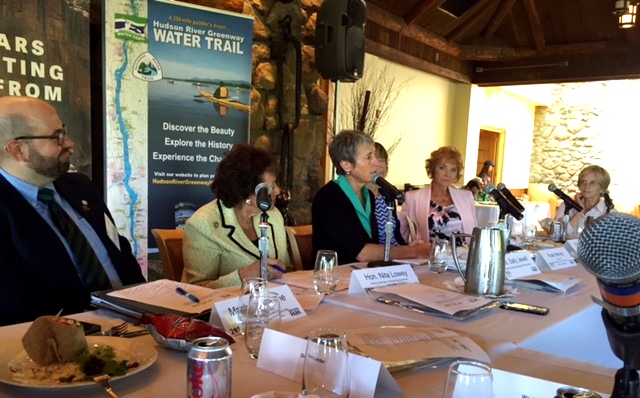How can we be more inclusive and engage future generations to be passionate advocates of historic sites and parks? That was the question at a recent gathering of national and state preservationists at Bear Mountain State Park in late August.
The National Park Service (NPS) is celebrating its centennial this year. With record breaking visitation, it is also mindful that more must be done to inspire new audiences and stewards in the next 100 years. As part of that planning, U. S. Secretary of the Interior Sally Jewell started off on a nationwide tour of NPS sites beginning with a historic first time visit to New York’s Hudson Valley.
Secretary Jewell’s itinerary included an hour long roundtable with park stakeholders and statewide preservation leaders. She invited suggestions from the attendees about ways to protect our country’s historical and cultural sites while also making them relevant and inclusive of all people.
 The Jay Heritage Center was proud to be part of this historic panel and exchange ideas with Devin Lander, the New York State Historian, colleagues from the Preservation League of New York State, the Museum Association of New York, Historic Hudson Valley, Scenic Hudson and many other park advocates.
The Jay Heritage Center was proud to be part of this historic panel and exchange ideas with Devin Lander, the New York State Historian, colleagues from the Preservation League of New York State, the Museum Association of New York, Historic Hudson Valley, Scenic Hudson and many other park advocates.
Appropriately, we met in a vaulted room of the landmark Bear Mountain Inn which was constructed of local stone and timber and built by park employees in 1915. The structure has been declared the finest example of Adirondack architecture in the country. Its craftsmanship is breathtaking. It was in that amazing hall that each member of the forum had a chance to voice his or her observations about the challenges and opportunities before us: from the growing importance of integrating technology into our offerings, to the ever changing demographics and needs of students and communities, particularly the imperative to facilitate transportation for Title 1 schools, to using parks as outdoor classrooms to promote discussions about sustainability.
We all agreed that the 4th graders of today are not the 4th graders of 50 or even 25 years ago. How do we get them to appreciate the stories and people behind the buildings and parks that they visit? How do we make those visits affordable and meaningful once they get there? Classrooms and curricula have changed as communities have grown and diversified. Social media has changed how we exchange information and how we connect with others. That has been true since long before the musical sensation Hamilton came to the stage. Above all, everyone agreed that one of the priorities for NPS in the next 100 years is to ensure that our parks are more accessible and that the American narrative we share truly represents our rich diversity and many cultural influences.
Last year the White House and the National Park Foundation launched the “Every Kid in a Park” initiative to give children greater access to the millions of public lands, forests and historic treasures in our country. In our own communities we can take similar measures to introduce young people to the amazing resources and landmark places in their own backyards. With every kid in a park, whatever their age, we can all be in the many rooms where IT happens – the IT being a lifelong love of history and commitment to protecting our shared heritage. Our historic sites and parks are those outdoor rooms – do your part to support them.
Photos: Above, (L-R) Mark Castiglione, Acting Director of the Hudson River Valley National Heritage Area, U.S. Representative Nita Lowey, Commissioner of the New York State Office of Parks, Recreation and Historic Preservation Rose Harvey, and Deputy Commissioner for Historic Preservation Ruth Pierpont and below, Secretary Jewell holds a JHC “Striving for Freedom”teacher’s folder while thanking Congresswoman Lowey for hosting the events of the day, provided.
